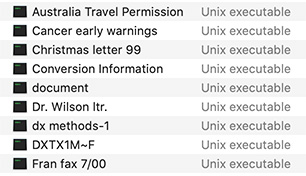Tip #1356: Fixing Unix Executable Files
… for Codecs & Media
Tip #1356: Fixing Unix Executable Files
Larry Jordan – LarryJordan.com
Most of the time, simply adding the correct file extension fixes this problem.


Most of the time, your images, media and documents open when you need them on a Mac. However, if you discover your files are suddenly unopenable “Unix executables,” here’s how to fix it.
In most cases, a Unix executable is a file stored on a server without a file extension. Most of the time, simply adding the correct file extension fixes this problem.
NOTE: Files stored on a Mac use other indicators to track which application created the file. However, file servers don’t use the Mac operating system and require file extensions to properly store and access files.
The trick is figuring out what’s the right extension. Generally, I try to find a similar file created around the same time. Select the file that works and type CMD + I. In the Get Info window that appears, look in the Name & Extension field to determine the correct extension to use.
For example, most of my early (1995 – 2010) digital videos were saved as QuickTime movies. Simply adding .MOV as a file extension solved the problem.
EXTRA CREDIT
I’ve also run into problems with older image files and word processing documents. Adding file extensions fixed the problem with these, too.


What if the Unix executable files were originally folders containing photos. What should the file extension of the folder be please?
Starting with the “2018” version, I believe, Premiere Pro stopped recognizing files without extensions.
I recall upgrading, and then recoiling in horror as many of my personal family video transfers, and a huge sfx library I’ve had for years, suddenly disappeared! Same trick as above…just went thru, and added extensions (mostly .MOV and .WAV), which fixed the problem.
Remember when Macs “didn’t need extensions”. ROFLMAO.
Mike:
Yes, but… That was also the time that Mac’s didn’t talk to Windows or Linux, either.
Larry